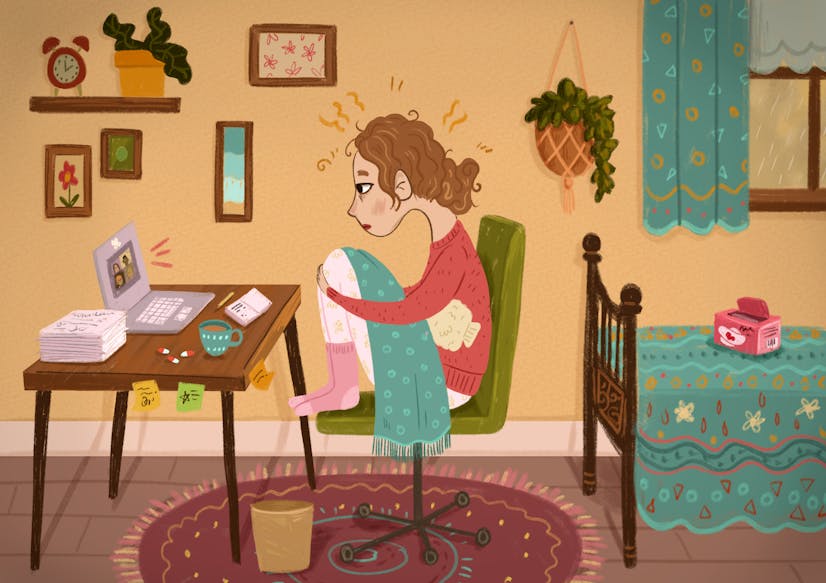This Is What Menstruation Looks Like Around the World
Here are 10 illustrations of what the “time of the month” looks like for women across the globe.

Menstruation is still somewhat of a taboo topic for some people, especially in third-world countries where it is often associated with workplace sexism and female job efficiency. However, conversations surrounding women’s health have come a long way.
For example, some countries like Spain have proposed new legislation that allows women to take several days of “menstrual leave” each month. Other countries that allow menstrual leave include Indonesia, Japan, South Korea, and Taiwan. Although the law in certain regions requires companies to allow women to take these few days off, the law does not mandate the companies to provide paid leave or extra pay for those who choose to work during menstruation. So, is it really a win for women?
Jump to:
Our methodology and task description
We asked ten female artists from ten different countries to illustrate what menstruation looks like for the average woman in their country. The countries include:
- The United States
- Spain
- England
- Ireland
- India
- Japan
- Canada
- Germany
- Mexico
- Brazil
We gave artists full creative freedom along with the following general directions:
Illustrate menstruation. The idea is to illustrate a woman on a day of menstruation to make a statement about how menstruation is viewed and governed in your country. We are looking to explore how perceptions of menstruation change across the world. Multiple designers are involved. You have full creative freedom, but a female must be depicted somewhere in the drawing. No nudity.
Ten “time of the month” illustrations
United States

Artist: Nina W.
Spain

Artist: Aitana G.
England

Artist: Cassie S.
Ireland

Artist: Dearbhla R.
India

Artist: Bianca S.
Japan

Artist: Junko O.
Canada

Artist: Marianne V.
Germany

Artist: Tatyana S.
Mexico

Artist: Gabriela I.
Brazil

Artist: Naomi S.
Patterns and artistic observations
After receiving the submissions, we noticed that four out of ten illustrations clearly depicted a woman in physical agony, shown through facial expressions of discomfort and pain. These depictions came from the artists of the United States, Spain, Ireland, and Japan.
The artists from Canada, Mexico, India, and Brazil created illustrations of a woman purchasing menstrual hygiene products, considered non-essential luxury goods in most of those countries. Many women often cannot afford certain menstrual products and must set budgets to buy necessities. This is especially depicted in the Canada illustration, where a woman is shown having to choose between purchasing pads or groceries.
The illustration submitted from England highlighted all of the symptoms that women in that country often have to endure, including some that aren’t talked about as much, such as brain fog and insomnia.
Lastly, the illustration from Germany depicts a woman walking into a small-town church bathroom and being pleasantly surprised to see a carton of feminine hygiene products.
Menstrual health trends and laws across the globe
Despite society’s changing times, there is still a lack of access to proper female menstruation hygiene in many countries due to its stigma. Additionally, menstrual leave is currently only offered in a few countries worldwide, such as South Korea and Indonesia. Among the ten countries we commissioned these artists from, only two allow menstrual leave: Spain and Japan.
Importance of menstrual leave
In Spain, women who suffer from severe period pain are allowed to take medical leave. While Spain is the first country in Europe to provide this benefit, many European countries may gradually follow and provide more flexibility for women in the workplace. In fact, in Ireland, menstrual and menopausal symptoms cause roughly 70% of women to take time off work, which explains why many of them have advocated for menstrual-friendly workplace policies.
Many women experience severe pain and uncomfortable symptoms with their periods every month. Menstrual leave allows them to take time off and recover, just for a few days. Additionally, menstrual leave policies are designed to eliminate the taboo and stigma surrounding periods and, instead, recognize the physical discomforts that menstruation can cause.
Abolishing the “tampon tax”
Some countries, such as Germany, have slashed their tax on tampons and other female sanitary products, no longer referring to them as “luxury” goods. As of January 1st, 2020, Germany’s tampon tax went from 19% down to 7%, a hopeful step toward a tax system that does not discriminate against women for their natural periods. Other countries that have abolished or reduced taxes for menstrual products include:
- Canada
- India
- Australia
- Kenya
- Colombia
- Rwanda
However, the tampon tax is still a major concern in many countries trying to overcome the label of “luxury” when it comes to necessary, basic menstrual care products. Within the United States, women are estimated to spend an additional $150 million per year on menstrual products alone. As of 2021, 32 states have introduced measures to eliminate the tax, but only 13 have succeeded.
Fair use statement
Innerbody Research is committed to providing objective, science-based suggestions and research to help our readers make more informed decisions regarding health and wellness. The reason why we invested the time and effort into creating this page is to raise awareness for female reproductive health and menstruation laws around the globe. We hope to reach as many people as possible by making this information widely available. As such, please feel free to share our content for educational, editorial, or discussion purposes. We only ask that you link back to this page and credit the author as Innerbody.com.
References
-
Bach, N. (2019, June 11). Tax free. period. seeks to eliminate the tampon tax across the U.S. Fortune. Retrieved July 6, 2022, from https://fortune.com/2019/06/11/tampon-tax-us-states/.
-
D'Souza, D. (2022, February 18). What is the tampon tax? Investopedia. Retrieved July 6, 2022, from https://www.investopedia.com/tampon-tax-4774993#.
-
France 24. (2022, May 17). Spanish cabinet approves paid 'menstrual leave'. France 24. Retrieved July 6, 2022, from https://www.france24.com/en/live-news/20220517-spanish-cabinet-approves-paid-menstrual-leave.
-
Jessica L. Barnack-Tavlaris, Kristina Hansen, Rachel B. Levitt & Michelle Reno (2019) Taking leave to bleed: Perceptions and attitudes toward menstrual leave policy, Health Care for Women International, 40:12, 1355-1373. Retrieved July 6, 2022, from https://www.tandfonline.com/doi/abs/10.1080/07399332.2019.1639709?journalCode=uhcw20.
-
Tax Free. Period. (n.d.). Retrieved July 6, 2022, from https://www.taxfreeperiod.com/.



